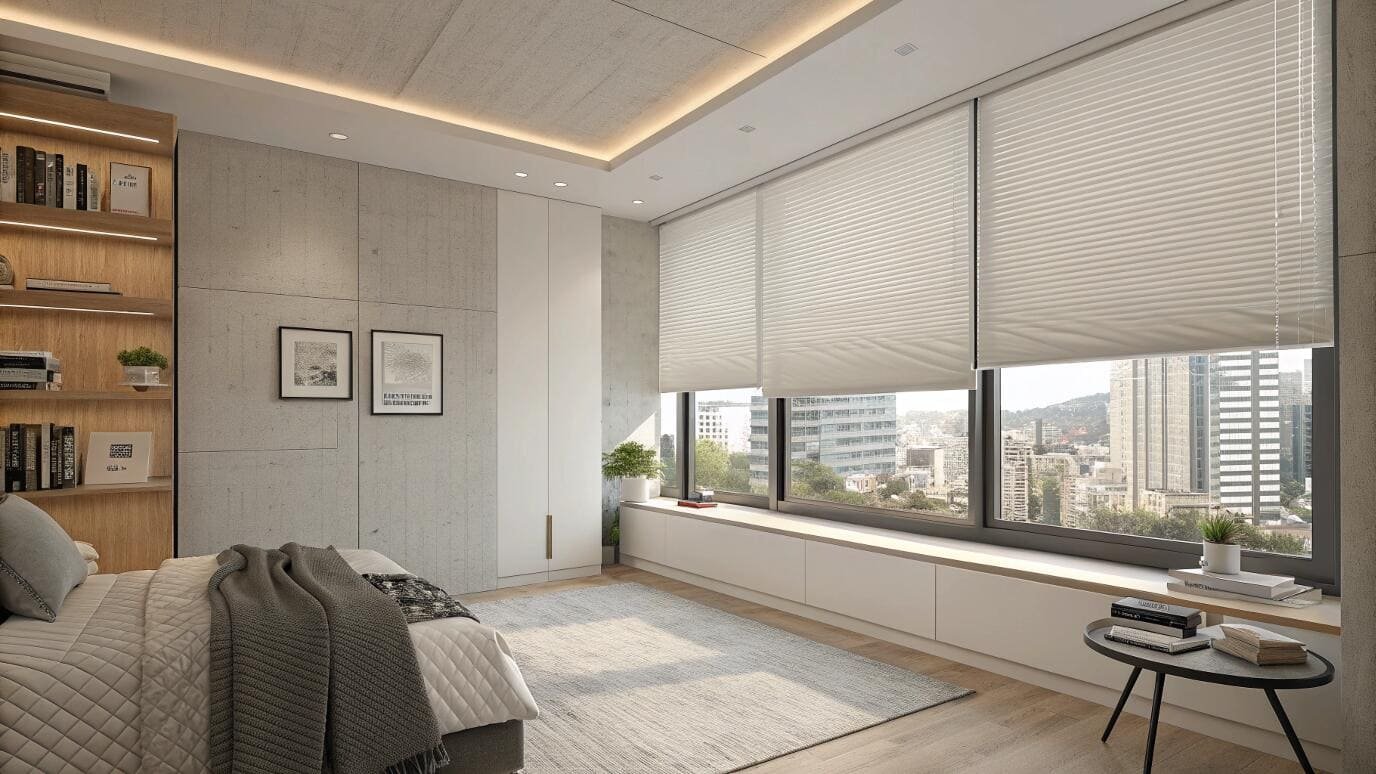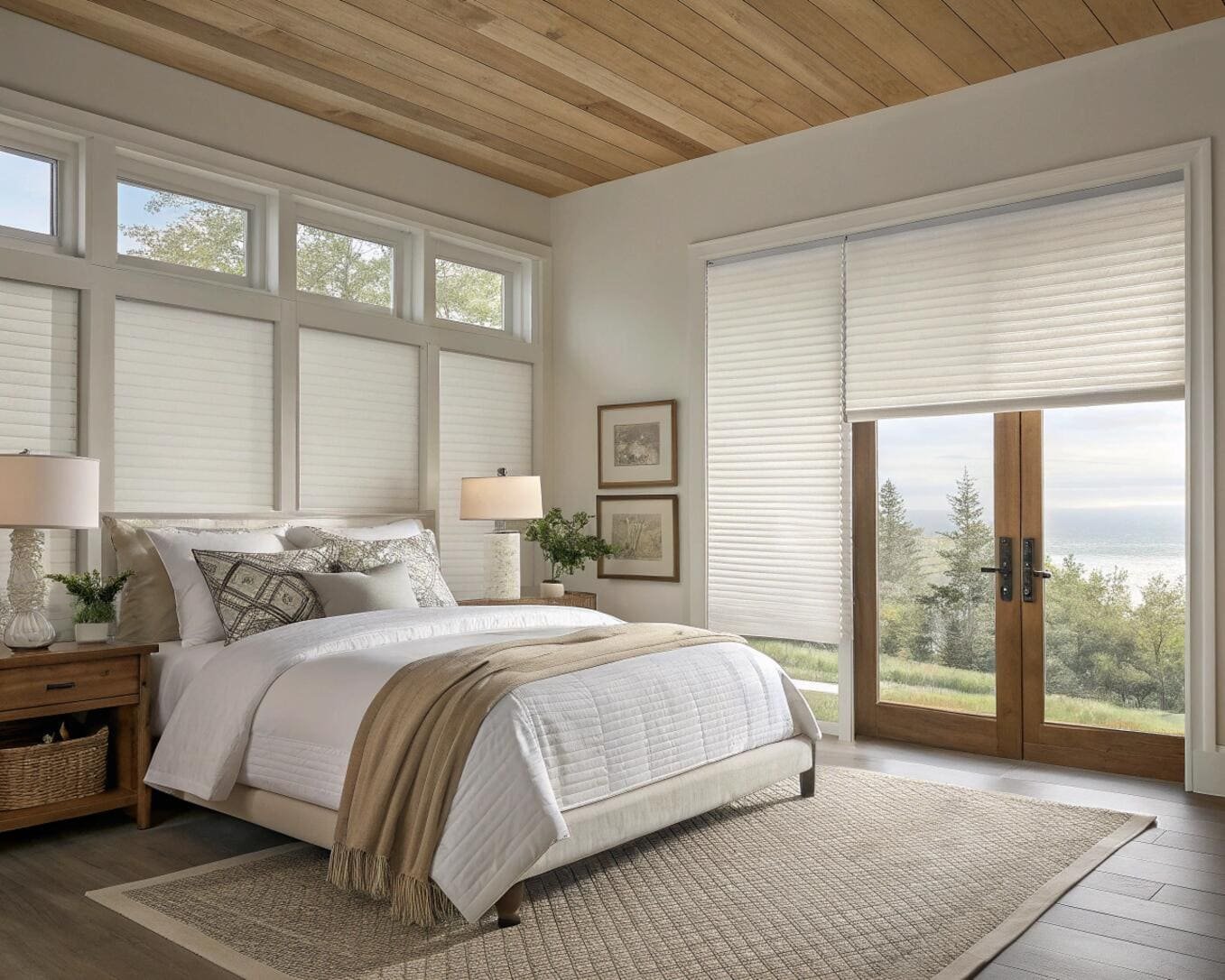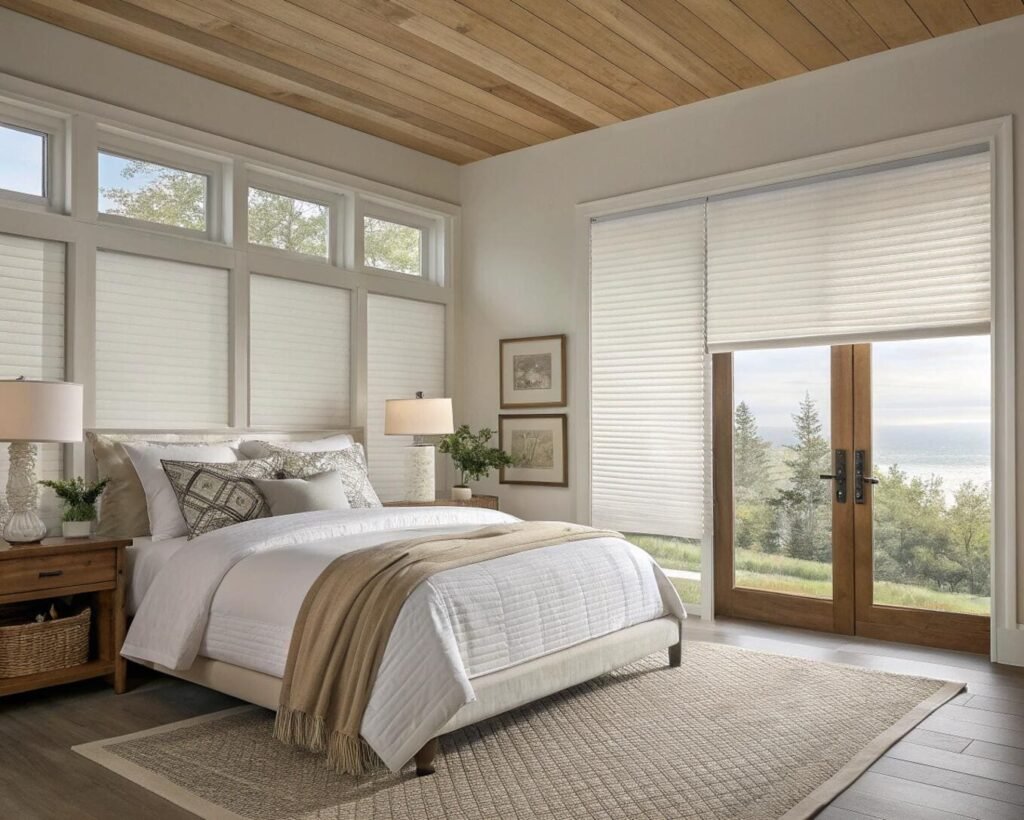Choosing between Roman and cellular shades for a project can be difficult. The wrong choice can compromise your design vision or your client’s comfort. Let’s compare them to find the right fit.
Roman shades[^1] offer classic, decorative style with a wide range of fabrics. Cellular shades provide superior energy insulation and a modern, minimalist look. The best choice depends on whether your project prioritizes aesthetics (Roman) or performance (cellular).

I consult with interior designers and contractors on this exact question almost every day. Both are excellent window treatment[^2]s, but they serve very different primary purposes. One is an expert in style and texture, while the other is an engineering solution for comfort and energy savings. Understanding their core strengths and weaknesses is the only way to specify the right product for your client’s needs. Let’s break down the key differences to make your decision easier.
Are Roman shades better than cellular shades?
You want to choose the "better" blind for your project. But this question can be misleading without more context. The best choice depends entirely on your project’s main objective.
Neither shade is universally better. Roman shades are better for achieving a specific decorative look with luxurious fabrics. Cellular shades are decisively better for insulation, energy efficiency, and functional light control.
When a client asks me which is "better," I always ask back, "What is the most important job for this window treatment?" The answer to that question tells us which product is the superior choice for that specific situation. They excel in completely different areas. Trying to compare them directly without context is like asking if a sports car is better than a cargo van. One is built for performance and style, the other for pure utility. Let’s look at how they stack up on the most important metrics for any project.
Head-to-Head Comparison
| Feature | Roman Shades | Cellular Shades (Honeycomb) |
|---|---|---|
| Aesthetics | Winner. Luxurious, classic, highly decorative. | Functional, minimalist, modern. |
| Insulation | Poor to Fair. | Winner. Excellent, high R-value. |
| Light Control | Good. | Winner. More versatile options. |
| Durability | Fabric dependent. | Very good. |
| Cost | Higher initial cost. | Lower initial cost, high long-term value. |
How do Roman shades and cellular shades differ in light control and privacy features?
You need precise control over light and privacy to create the perfect room atmosphere. A blind that is too sheer or too opaque can miss the mark. These two shades handle light very differently.
Roman shades offer good light control with fabrics and liners that can be light-filtering or blackout. Cellular shades provide more advanced options like the top-down/bottom-up system, offering more flexible control over both light and privacy simultaneously.

The biggest functional difference here is the lift system. A Roman shade is essentially one piece of fabric. You can raise it or lower it, and you can add a blackout liner for room darkening, but the operation is basic.
Cellular shades, on the other hand, offer more sophisticated solutions that I often recommend for bedrooms and street-facing rooms.
- Top-Down/Bottom-Up: This is the killer feature. It allows you to lower the shade from the top to let in natural light while keeping the bottom half of the window covered for privacy. It’s the best of both worlds.
- Day/Night Shades: This is another great cellular shade option. It combines two separate fabrics into one headrail—usually a sheer fabric for daytime and a blackout fabric for nighttime.
Roman shades are simpler, while cellular shades are engineered for more complex light and privacy challenges.
Which window treatment offers better aesthetic versatility: Roman shades or cellular shades?
Your project has a specific design language. The window treatments must match it perfectly. A bland or mismatched shade can weaken the entire design. Roman shades are the clear winner here.
Roman shades offer vastly superior aesthetic versatility. With thousands of available fabrics, patterns, and colors, plus different fold styles, they can be customized to fit any decor from traditional to contemporary.

When the window treatment needs to be a central design element, I always steer my clients toward Roman shades. They are essentially a piece of custom upholstery for your window.
Roman Shade Customization:
- Fabric: You can choose from cotton, linen, silk, velvet, durable synthetics, and countless blends.
- Pattern: The options are limitless: solids, stripes, florals, geometrics, abstract designs.
- Fold Style: You can specify different styles like a classic flat fold for a clean look, or a hobbled/teardrop fold for a more voluminous, traditional appearance.
Cellular shades, by contrast, have a very specific look. Their aesthetic is clean, uniform, and minimal. Their versatility comes from a wide range of solid colors, not from patterns or textures. If your project follows a minimalist or modern aesthetic, cellular shades fit in beautifully. But if you need a decorative statement piece, Roman shades are the answer.
What is the downside of Roman blinds?
You’re attracted to the beautiful look of Roman shades. But before you specify them, you need to understand their functional limitations. Their design has some inherent disadvantages.
The primary downsides of Roman shades are their poor energy insulation, their bulkiness when raised, and the difficulty of cleaning delicate fabrics. They simply lack the performance features of more modern blinds.
Roman shades are all about form over function. I always make sure designers are aware of these trade-offs before they commit to them for a project.
- Poor Insulation: A standard Roman shade is just a single layer of fabric. It offers minimal resistance to heat transfer, meaning it doesn’t do much to lower energy bills. Adding a liner helps, but it still can’t compete with a cellular shade’s structure.
- Stack Height: When you raise a Roman shade, the fabric gathers in neat folds at the top. This "stack" can be quite thick, especially with heavy fabrics, and can block a significant portion of the view and light from the top of the window.
- Cleaning & Durability: Delicate fabrics like silk or linen can be difficult to clean if they get stained and may require professional help. They are also more susceptible to fading from direct sun exposure over time.
What is the downside of cellular blinds?
You need the high performance of a cellular shade. But what are the trade-offs? Their highly functional design comes with its own set of disadvantages you should know about.
The main downsides of cellular shades are that their cells can trap dust and debris, making them harder to clean. They also offer no outside view when closed, and some people find their look too plain for decorative spaces.

When I supply cellular shades for a project, I am always transparent about these three points. Knowing them ahead of time ensures the client is happy in the long run.
- Cleaning: This is the most common issue. The open honeycomb cells are horizontal pockets that are perfect for catching dust. They require regular vacuuming with a brush attachment to keep them looking clean.
- No View-Through: Unlike a venetian blind that can be tilted, a cellular shade is a solid sheet. When it’s down, your view is completely blocked. You have to raise the shade to see outside. The top-down/bottom-up feature helps, but it’s a fundamental difference.
- Minimalist Aesthetics: Their look is clean and functional, but it is not decorative. For a room that demands a rich texture or a bold pattern, a cellular shade can look too simple or even utilitarian.
Which requires more maintenance and cleaning effort: Roman shades or cellular shades?
You need to specify a low-maintenance product for your project. No one wants to spend a lot of time cleaning their blinds. The answer here depends on the type of cleaning required.
Cellular shades require more frequent, routine dusting to keep their cells clear. Roman shades require less frequent dusting but are much harder to deep clean if they get stained, especially with delicate fabrics.
It’s a trade-off between frequent light cleaning and difficult deep cleaning[^3]. I always advise my clients to consider the environment where the blind will be installed. For a kitchen, where splashes and stains are possible, a durable cellular shade that can be spot-cleaned is a better choice. For a formal, low-traffic living room, a Roman shade might be perfectly fine.
Cleaning Comparison
| Cleaning Task | Roman Shades | Cellular Shades |
|---|---|---|
| Routine Dusting | Easier (flat surface). | Harder (requires vacuuming cells). |
| Spot Cleaning | Difficult (risk of water marks on fabric). | Easier (durable polyester fabric). |
| Deep Cleaning | Very Difficult (often requires professional help). | Not possible for internal cells. |
Do cellular shades look cheap?
You’re considering cellular shades for their performance, but worry they might cheapen the look of a high-end project. This is a common misconception that comes from low-quality retail versions.
No, high-quality[^4], custom-fit cellular shades do not look cheap. They provide a crisp, clean, and modern aesthetic that is highly valued in contemporary interior design. Their minimalist look is intentional and sophisticated.
The perception of "cheapness" usually comes from seeing old, dusty, or poorly fitted off-the-shelf versions. When you specify a quality cellular shade for a project, you’re getting a very different product. Our VelaBlinds cellular shades feature perfectly crisp pleats that don’t sag, high-quality polyester fabric with a substantial feel, and sleek, low-profile headrails. In a modern, minimalist, or Scandinavian-style interior, their clean lines look purposeful and elegant. The key is context. In a very ornate, traditional room full of heavy furniture, their minimalist style might look out of place. But that’s a style mismatch, not a sign of a cheap product.
How do Roman shades and cellular shades compare in initial cost and long-term value?
Every project has a budget. You need to balance the upfront cost of the product with the long-term benefit it provides to the client. This is where these two shades really diverge.
Roman shades typically have a higher initial cost, especially for custom fabrics. Cellular shades have a lower initial cost and provide significant long-term value through their energy savings, offering a better return on investment.

When I work with project buyers like Emma, we often talk about Total Cost of Ownership.
- Initial Cost: A basic cellular shade is almost always less expensive than a basic Roman shade. The cost of a Roman shade can increase dramatically based on the fabric you choose.
- Long-Term Value: This is where cellular shades excel. The money they save on heating and cooling bills every year adds up. Over their lifespan, they can easily pay back the initial investment and then some. A Roman shade offers very little financial return in this way.
For a project focused on budget and performance, cellular shades offer unbeatable value. For a project where aesthetics are the only concern and the budget is flexible, Roman shades are a beautiful luxury investment.
What is the lifespan of cellular blinds?
You’re specifying a product you expect to last. Durability and longevity are crucial for client satisfaction and your reputation. You need to know how long these blinds will perform.
A quality cellular shade, made with durable polyester fabric and a good lift system, has a typical lifespan of 7-10 years. With proper care and in a low-sunlight environment, they can last even longer.
As a supplier, I know that product longevity is critical. We build our cellular shades to last. The key factors that influence lifespan are:
- Material Quality: Resilient, spun-lace polyester fabric resists fading and holds its pleats. A cheap fabric will sag and discolor much faster.
- Operating System: The internal cords and headrail mechanism are vital. Motorization can actually extend the life of a shade by ensuring a smooth, even pull every time, reducing wear and tear.
- Environment: A blind in a room with intense, direct afternoon sun will have a shorter lifespan than one in a room with indirect light. Regular cleaning to remove abrasive dust also helps preserve the fabric.
Which provides better energy efficiency and insulation: Roman shades or cellular shades?
Reducing energy costs is a major goal for many building projects. Windows are a primary source of heat loss. The choice of window treatment can make a huge difference.
Cellular shades provide far superior energy efficiency and insulation. Their honeycomb structure traps air, creating a thermal barrier that can reduce heat loss through a window by 40% or more. Roman shades offer very little insulating value.

This is not a close competition; it’s the core difference between the two products. I explain it to my clients using R-value, which measures insulation. A typical double-pane window has an R-value of about 2.0. A Roman shade adds very little to that. A high-performance double-cell cellular shade can add an R-value of 3.5 or more, effectively more than doubling the window’s insulating power.
This trapped air pocket in the cellular shade’s honeycomb design is what works the magic. It keeps the warm air inside during the winter and the hot air outside during the summer. This reduces the strain on your HVAC system year-round, leading to significant and measurable energy savings. If energy efficiency is a key project requirement, cellular shades are the only logical choice.
Conclusion
Roman shades excel in aesthetic customization for a classic look. Cellular shades are unbeatable for energy insulation and functional light control. Choose based on your project’s number one priority: style or performance.
---
[^1]: Explore the classic elegance and customization options of Roman shades for your design projects.
[^2]: Explore various window treatment options that maximize energy efficiency in your home.
[^3]: Learn the best practices for cleaning Roman shades to maintain their beauty and longevity.
[^4]: Discover the features that distinguish high-quality cellular shades from lower-end options.Partner with VelaBlinds for Your Next Project
Smart window treatments shouldn’t be complicated. After working with 500+ distributors and contractors worldwide, I’ve streamlined the process to get you quality products, competitive pricing, and reliable support – every time.
Why project professionals choose VelaBlinds:
- ✅ Fast, Accurate Quotes – Detailed specs and pricing within 24 hours
- ✅ Transparent Pricing – No hidden fees, volume discounts clearly outlined
- ✅ Quality Assurance – Direct partnerships with certified OEM manufacturers
- ✅ Project Support – Dedicated account manager from quote to delivery
Start your next project:
📧 Quick Quote: Send your requirements to info@velablinds.com
📱 Direct Contact: WhatsApp +86 137 2012 8317
🌐 Browse Solutions: https://velablinds.com/
📁 Product Resources: Access spec sheets, catalogs & project files
Jimmy Chen, Founder
"I built VelaBlinds to solve the real challenges I faced as a project buyer – long lead times, unclear specs, and unreliable suppliers. Let’s discuss how we can power your projects with smarter blinds."
Serving distributors and contractors across North America, Europe, and Australia since 2018.





